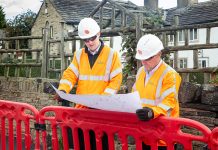Designed to make water microbiology simple, IDEXX provides easy, rapid and accurate testing methods, along with a full line of water testing supplies, equipment and accessories, allowing users to quickly and efficiently identify contamination in their water.
The need to quickly identify and resolve bacterial contamination in drinking water systems is well understood by water utility companies. Failure to spot problems can be extremely costly, both financially and in terms of reputation. Likewise, dealing with false alarms can waste valuable time and resources.
Colilert-18®, from IDEXX, has been trusted by water utilities worldwide for more than 20 years for the detection of coliforms and E.coli in drinking water, sewage and raw water. Its speed to confirmed results, in just 18 hours, as well as its many advantages over traditional membrane filtration methods, have seen Colilert-18 achieve global regulatory acceptance in over 40 countries, and become the new ISO standard 9308-2:2012. In 2013, over two billion people globally were served by Colilert tests.
In October 2015, Colilert-18 was specified as a reference method in the European Drinking Water Directive 2015/1787. The amendment to the Directive now states that “EN ISO 9308-2 (Colilert-18) provides all necessary specifications for performing the enumeration of E. coli and total coliform bacteria.” The Directive gave European countries 24 months to transpose the legislation into national laws, meaning this has to be implemented by October 27th, 2017 at the latest.
Using Colilert-18 on a long-term basis delivers precise results rapidly and provides confidence in results for water network operators. Detecting coliforms quickly and accurately reduces the prospect of sporadic contamination events caused by the spread of biofilm through water distribuiton systems. Subsequent remedial activities can be extremely serious, especially if actions such as hyper-chlorination of distribution systems, cleaning up biofilm, draining reservoirs and even replacing pipes, are forced upon network operators. So removing uncertainty and doubt from test results ensures the ongoing maintenance of the network, regulatory compliance and the safety of the consumer.
Speed and Efficiency
Tests come pre-weighed and pre-packed and there are no media preparation steps, reducing the actual hands-on time to prepare a sample to just one minute. Conclusive and confirmed results are available in 18 hours, allowing any necessary remedial action to be carried out immediately.
Combining the Colilert-18 test with the easy-to-use IDEXX Quanti-Tray® system displays results in a series of wells where a yellow colouration shows the presence of coliforms and fluorescence under UV light indicates whether E.coli is present.
Accuracy and Confidence
Colilert-18 tests significantly reduce both false positive and false negative results and provide operators with results that are accurate, non-subjective and require no further confirmation steps.
Specificity and Sensitivity
Colilert-18 supresses the growth of non-target organisms while facilitating the growth of target species, making the test very specific and also highly sensitive. A single viable coliform or E. coli per 100 ml sample can be detected.
Quality and Assurance
In addition to the IDEXX Water QC laboratory being ISO 17025 accredited, the QC certificate for Colilert-18 is now ISO 11133 compliant, giving users considerable advantages over those that are reliant on other, non-compliant products.
Customers also benefit from IDEXX taking full ownership of the entire test process. If any element of the methodology falters, whether it is the equipment or an abnormal result that cannot be explained, technical support is always available.
Versatility
Colilert-18 can be used on all raw water samples, whether from rivers or reservoirs. The accuracy and ease of use becomes apparent when testing raw water which contains a lot of background flora that is supressed using Colilert-18, making interptetation of results much simpler. Furthermore, the test can be used in the production of sludge cake, where it is important to show a sufficient reduction on E. coli from raw sludge before it is released, as it is used as a fertiliser and could enter the food chain.
Methodology
The science behind the Colilert-18 test is based on a defined bacterial enzyme detection technology which simultaneously detects total coliforms and E. coli. Two nutrient-indicators, ONPG and MUG, are the major sources of carbon in Colilert and can be metabolised by the coliform enzyme ß-galactosidase and the E. coli enzyme ß-glucuronidase, respectively.
As coliforms grow in the Colilert medium, they use ß-galactosidase to metabolise ONPG and change it from colourless to yellow.
E. coli use ß-glucuronidase to metabolise MUG and create fluorescence. Since most non-coliforms do not have these enzymes, they are unable to grow and interfere. The few non-coliforms that do have these enzymes are selectively suppressed by the specifically formulated matrix of Colilert.
This approach is different from traditional media, which provide a nutrient-rich environment that supports the growth of both target organisms and non-targets. When non-targets grow and mimic target organisms, false positives occur. Growth of non-targets can also suppress target organisms and give false negatives in traditional media. To suppress non-targets, traditional media often include high levels of salts, detergents, or other selective agents that may inadvertently suppress target organisms and give further false negative results.
Carrying out the test and sample preparation require minimal training and equipment. The test itself consists of a powder which is added to a standard 100ml water sample, and then incubated at 35°C for 18 hours to determine presence or absence. Unlike traditional techniques, no media preparation is necessary, and the non-toxic reagents come in ready-to-use, unit-dosed packaging. Hands-on operation time is less than one minute, and the test has the potential to be run either within a laboratory environment or on-site, making the test ideal for situations where access to a contract laboratory is restricted, such as oil rigs and cruise ships.
If required, bacterial contamination can also be quantified using the IDEXX Quanti-Tray. Once the water sample is collected, the pre-dosed powder is added to the sample container, then agitated and poured in to the Quanti-Tray which has 51 wells specifically designed to enumerate bacteria in water samples. The Quanti-Tray is then sealed to create a number of discrete cells where the reaction will take place and then incubated.
All ®/TM marks are owned by IDEXX Laboratories, Inc. or its affiliates in the United States and/or other countries.
South West Water Adopts Colilert®-18 in Drive for Greater Accuracy and Certainty
After undertaking a trial in 2016 to compare Colilert-18 against the Membrane Lactose Glucuronide Agar (m-LGA) test which it had previously used for all compliance samples, South West Water (SWW) switched to Colilert-18 to test for E. coli and coliform contamination.
Uncertainty caused by false positive results had led to delays while confirmation tests were carried out, resulting in time and money being spent undertaking remedial actions which may not have been required. Regulations state that immediate action must be taken, based on the assumption that the result is positive.
SWW had noted that m-LGA can allow the growth of non-target background organisms which can mask the presence of coliforms on the agar. The water quality department at SWW was particularly concerned about unconfirmed failures, as these colonies led to uncertainty while confirmation steps were undertaken. It was found that after isolating presumptive positives from m-LGA, they had to be confirmed and this typically took two extra days, but with mixed colonies could be as many as four.
It was observed in the trial that Colilert-18 was not just easier to store and handle, it also greatly reduced the risk of contamination between samples. Unlike membrane filtration techniques, Colilert-18 is non-hazardous, and the processing time for SWW’s microbiologists undertaking testing with Colilert-18 was reduced, greatly improving their workflow and efficiency in the laboratory.
During the six month trial, over 10,000 samples were run, and although ultimately, the side-by-side comparison testing showed that m-LGA gave the correct results, it was very time consuming. Data analysis at the end of the six months showed there was no increase in compliance failures.
The trial gave the water quality experts within SWW the confidence to move over to Colilert-18 for their routine testing, and avoid the three-day wait for confirmed results. SWW has now joined Thames Water, South East Water and Essex & Suffolk Water in relying on Colilert-18 to test for E. coli and coliform contamination.







